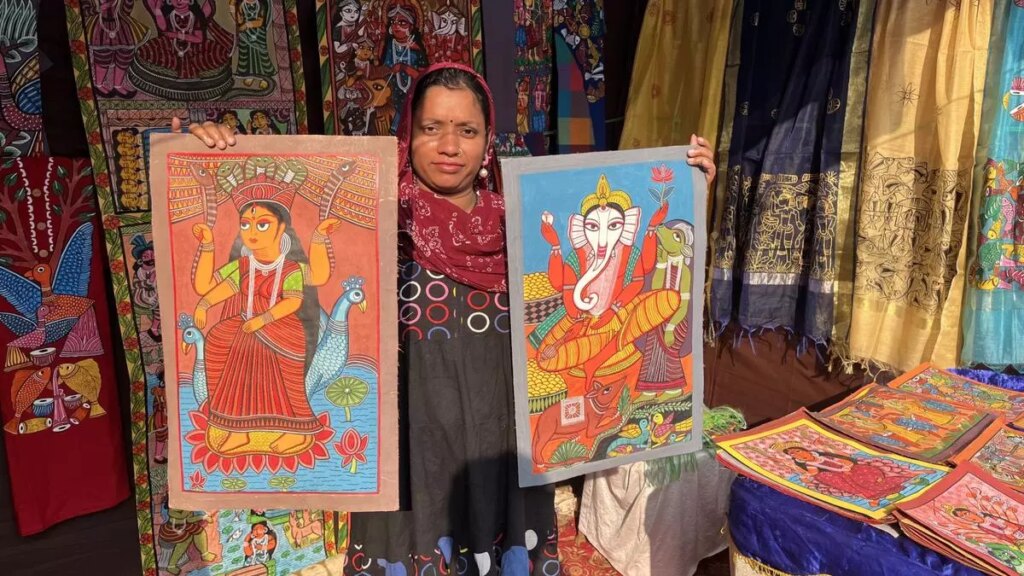In the days of old, the patachitra artists of Bengal would travel from village to village with their scrolls of paintings and songs of mythology and perform for entertainment. They would unfurl the scroll to display painted panels as they sang of what the scroll depicted, offering an audiovisual experience centuries before television was conceived of. According to some researchers, this folk tradition of visual storytelling goes back more than a thousand years.
Even as the nature of entertainment has changed radically with the passage of time, rendering many ancient art forms redundant, the Bengal patachitra tradition has not only managed to survive in the age of cyber tech, but with alterations and improvisations, has even found a growing market for itself, as was evident in the Patachitra Mela (fair) held in Paschim Medinipur district in December-January. One of the reasons this art form has not been reduced to a footnote in art history may be found in the tiny, obscure village of Naya in Pingla Block of Paschim Medinipur district.
All 176 households in Naya, known locally as Patua Gram (village of patuas, or patachitra artists) are engaged in making patachitras. Time appears to have stood still in certain ways in this village where this ancient art form is on display practically everywhere. Wandering around the village, one can see its residents—from young children to the elderly— painting either on canvases or on other media, including everyday household objects and utensils. The villagers, predominantly Muslim, have a common surname – Chitrakar, which means artist. Their art is their identity.
Also Read | Patuas of West Bengal sustain their art of storytelling through scrolls
They still make their products in the old way, manufacturing their own paint from natural resources, a tradition that has been handed down through the generations over centuries. For example, the colour yellow is often produced from turmeric, the grey from ashes of cow dung, the reddish-copper hue (often used for painting gods) from burnt earth, and the green from water spinach and various other vegetations.
After the colours are made, the artist stitches to a canvas the pieces of paper that serve as slides; then they paint the background and make the border designs. After that they make the outlines of the painting. When the artwork is complete, a cotton cloth is pasted on the back of the canvas to prevent it from tearing, and two sticks are attached to make it into a scroll. The artists also make the gum they use from Bel tree (Bengal Quince). A medium-sized patachitra will take a little over three weeks to make and is sold at around Rs.7,000. The slightly bigger ones can fetch up to Rs.15,000; the price of the very large patachitras can go up to several lakhs.
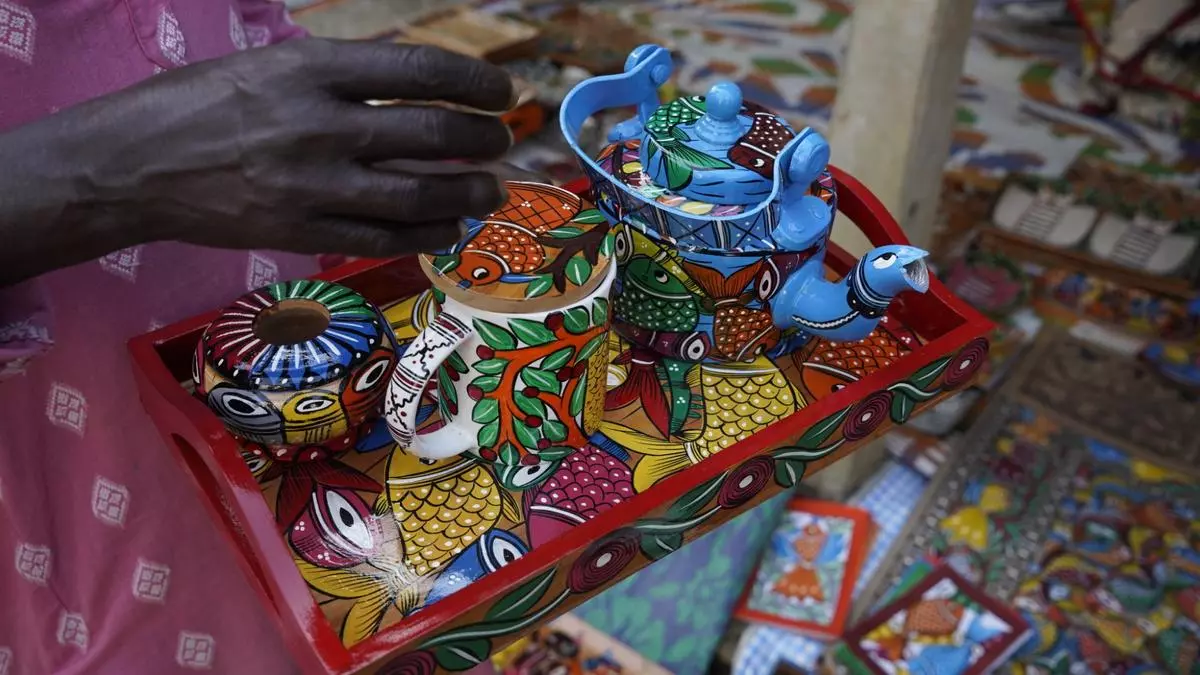
Patuas are now painting on household articles such as trays, coasters, mugs, kettles. These are popular and lucrative and help to keep the tradition alive.
| Photo Credit:
JAYANTA SHAW
Apart from the traditional mythological themes, patachitras also depict social issues such as child marriage, afforestation, AIDS, COVID, and popular stories and domestic situations. But according to the veteran artist Khadu Chitrakar, the connoisseurs and collectors still prefer mythological themes. “The new themes are alright for educational purposes and have novelty value, but people still prefer the old motifs; and that is why we still paint the stories of the Puranas and sing songs about them,” said Khadu.
He learnt his craft from his late father, Baneswar, and his grandfather Dari Chitrakar and can recollect how they travelled with their stories and paintings. “In the old days when there was no television, my grandfather would go from village to village and perform. They would give us clothes or rice as payment,” he said. Khadu, 64, in turn, has handed down his knowledge and repertoire of stories to his children. “My children have taken their art not just across India but also abroad,” he said with pride.
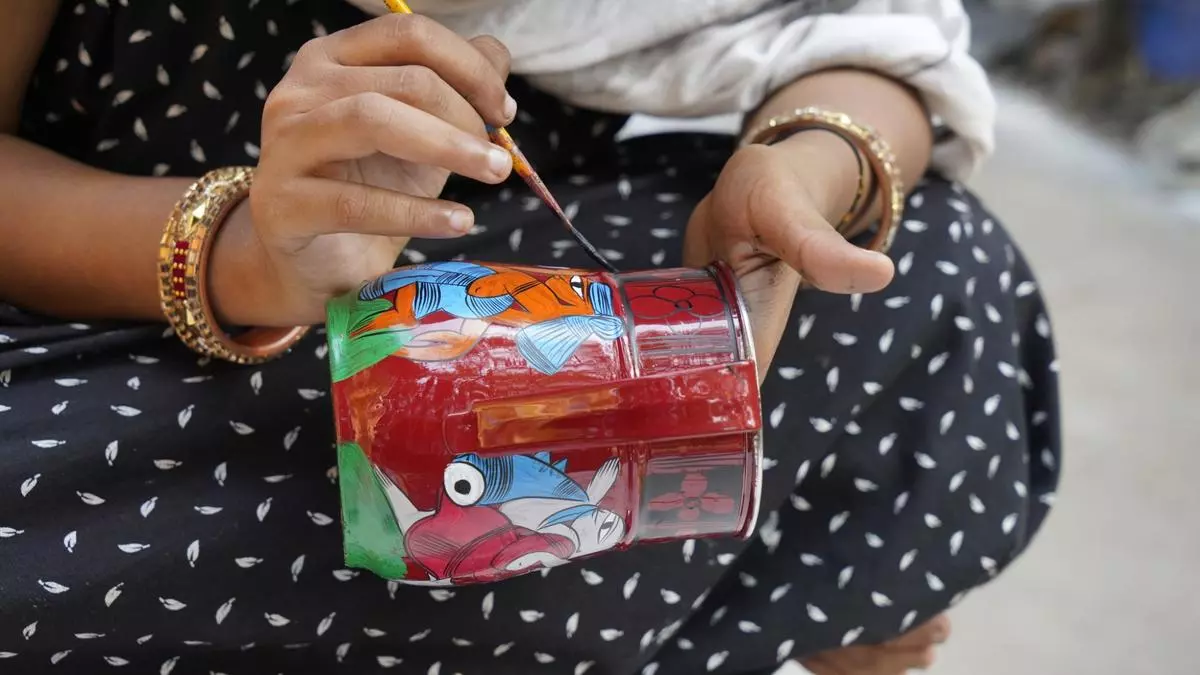
Patuas are now painting on household articles such as trays, coasters, mugs, kettles. These are popular and lucrative and help to keep the tradition alive.
| Photo Credit:
JAYANTA SHAW
A large, elaborately designed patachitra takes months to complete. Saramuddin Chitrakar has so far sold six large patachitras depicting stories from the Ramayana. One of these, which was commissioned by a collector in Lucknow, took six months to finish and fetched him Rs.2.5 lakh. When talking to Frontline, he was already working on another Ramayana-themed piece. “I sell one such big patachitra every year,” said Saramuddin.
“The big galleries and projects want the ancient stories of the Puranas, the Ramayana and the Mahabharata. Serious collectors don’t want the popular new subjects. Our ancestors made the ground for us through their depiction of the ancient myths and epics. We are merely continuing that. They made the original art, and got a pittance for it. We, on the other hand, are looking at things from a business perspective, and there is the fear of losing our heritage in pursuit of money.”
Rising to market demand
Though Saramuddin’s fears may not be totally unfounded, the diversification embraced by patuas has enabled the art to not only survive but also secure a captive market. Patachitra artwork on household goods such as vases, trays and tea sets is very popular now. The patuas of Naya have cottoned on to it, and with encouragement from the State government and the availability of regular platforms to showcase and sell their products, they have managed to keep the tradition going, albeit in a way that may draw the scorn of purists.
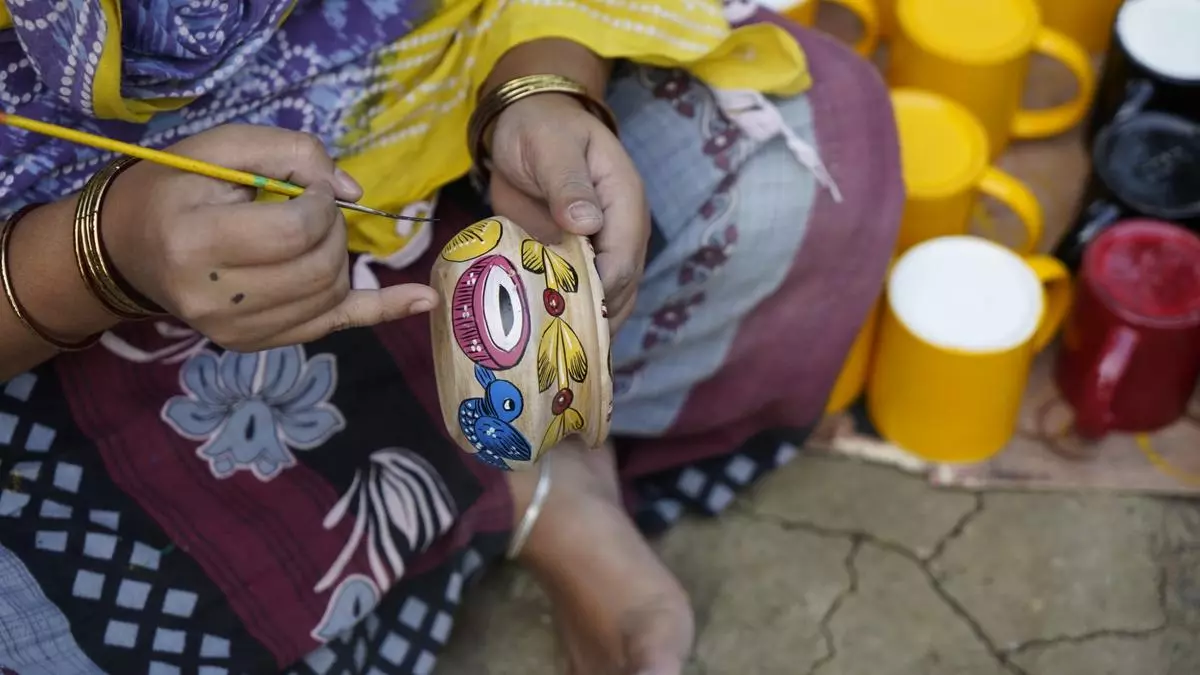
Patuas are now painting on household articles such as trays, coasters, mugs, kettles. These are popular and lucrative and help to keep the tradition alive.
| Photo Credit:
JAYANTA SHAW
Acclaimed patachitra artist Bahar Chitrakar, 70, pointed out that change in architecture has contributed to the decline in the demand for large patachitras. “Houses are not as big as they used to be for the walls to accommodate big patachitra paintings. We need to survive, so we started to reduce the size and paint on everyday household things, and these sell well everywhere,” Bahar told Frontline. At the same time, the artists believe that there is now once again a growing demand for traditional motifs in large canvases.
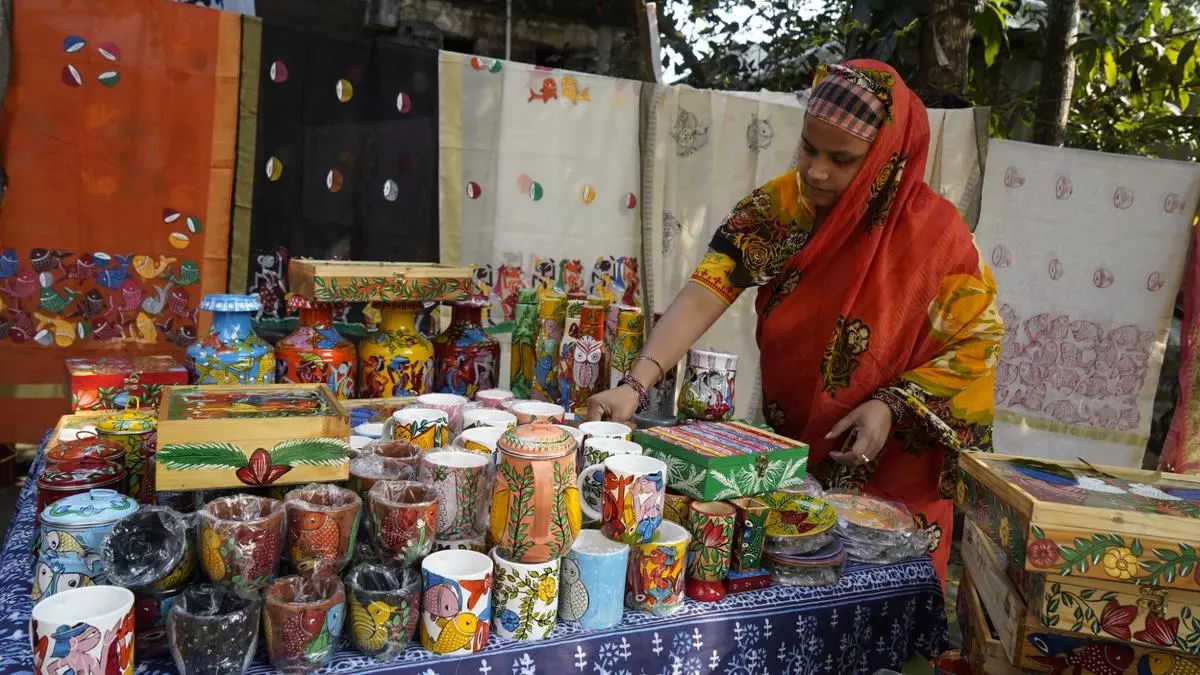
Patuas are now painting on household articles such as trays, coasters, mugs, kettles. These are popular and lucrative and help to keep the tradition alive.
| Photo Credit:
JAYANTA SHAW
The eminent historian and writer Tapati Guha-Thakurta, who is widely recognised for her work on art history, pointed to the emergence of a “new ethnic market” over the past couple of decades. “As you must have seen, the artists work as a family and they do a lot of work on different decorative surfaces. They are creating not just a work of art, but also a beautiful ethnic gift item that can be seen in stores like Byloom [popular handicraft store in south Kolkata]. At the same time, a group of very skilled artists are getting orders from corporate houses or museums, which may want a Durga pata or a Ramayana pata. But within these big pieces also you will find new innovations,” said Guha-Thakurta. According to her, the artists have risen to market demands.
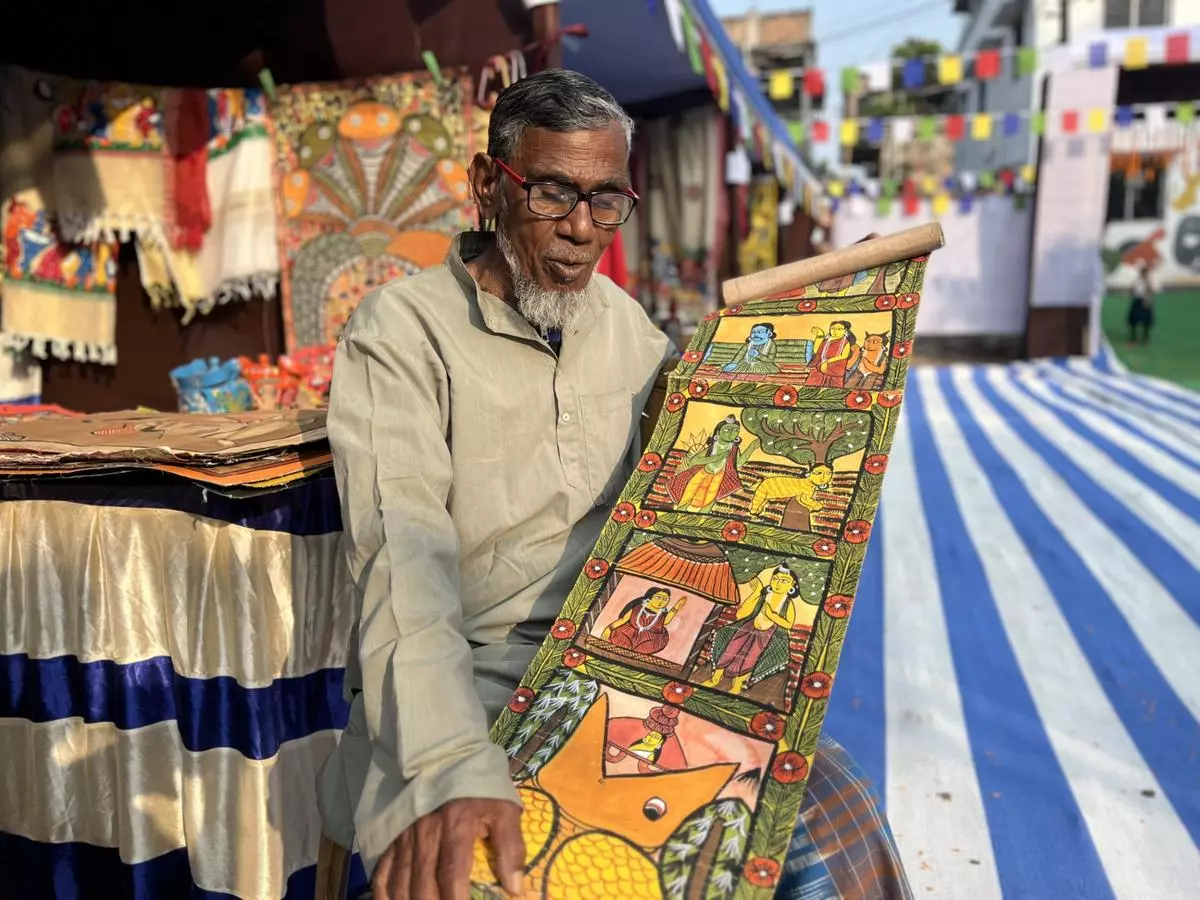
Ajoy Chitrakar with one of his creations. He remembers the hard times when, as a child, he travelled with his father from village to village with patachitra and songs in order to survive. Now the situation has changed.
| Photo Credit:
JAYANTA SHAW
The Patachitra Mela at Naya, organised by the State government every December, has grown from the initial two days to eight, pointing to a growing interest in patachitra art. “We realised people are coming from far and wide for this, and just two days were not enough. We are creating something unique and special. People love it and want to possess it,” said renowned patachitra artist Rahim Chitrakar.
Highlights
- Bengal’s tradition of patachitra is kept alive in Muslim-majority Naya village of Pingla block in Paschim Medinipur district, where all 176 households are engaged in making patachitras.
- The patuas now also paint on contemporary themes such as child marriage, afforestation, AIDS, COVID, but scrolls on mythological themes remain most sought-after, especially by connoiseurs.
- The patuas have diversified their craft by painting on household goods, which is very popular; and government initiatives like the annual Patachitra Mela in Naya village also helps to nurture the tradition.
Changing fortunes
The patuas are still very poor, with middlemen and dealers selling their art internationally at considerably high prices while paying the artists very little in comparison. Yet, the situation has improved perceptibly. Rahim’s father, Ajoy Chitrakar, remembers the hard times when, as a child, he travelled with his father from village to village with patachitra and songs. “We lived with a lot of sadness and disappointment because our art never got us any financial gains. We had to go to villages, otherwise we would starve. Today the situation has changed. We get orders from different parts of the country. The government and certain scholars have ensured that the whole world knows of our craft,” he said.
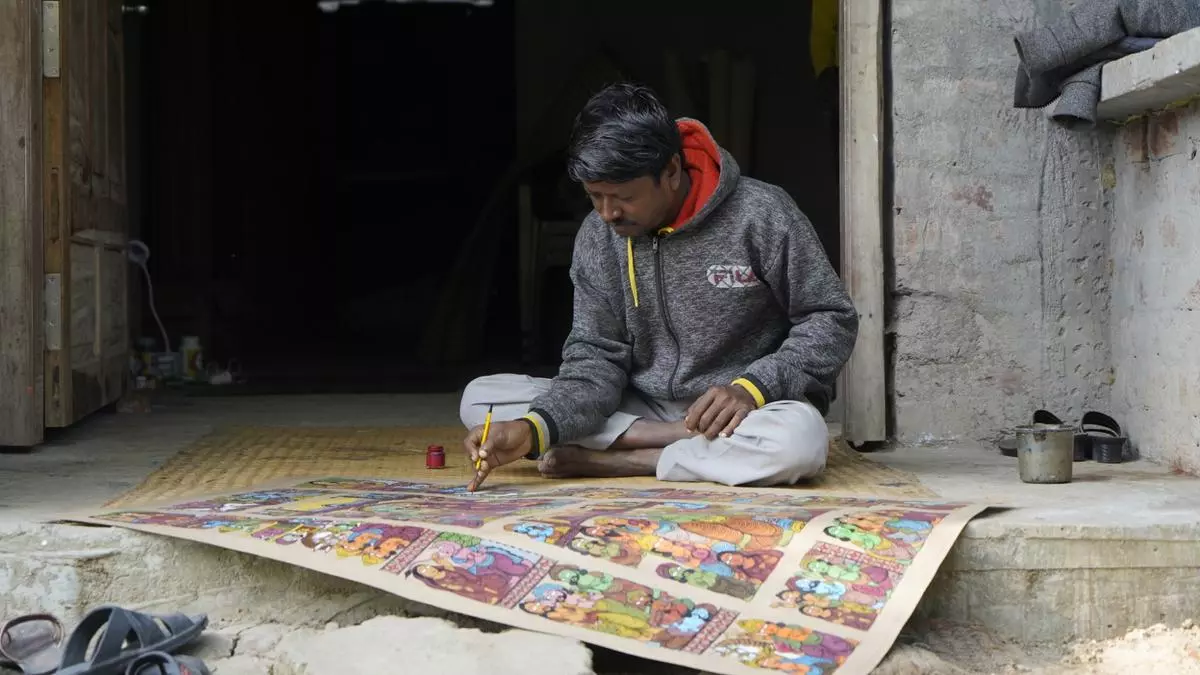
Saramuddin Chitrakar working on a Ramayana-themed patachitra at Naya, the Muslim-majority village in Paschim Medinipur where all 176 households are patachitra artists. All have the same surname, Chitrakar, which means artist.
| Photo Credit:
JAYANTA SHAW
However, even if the artists have become more market savvy, most still remain quite unconcerned about personal fame – as is evident in the lack of proprietorial feeling about their creations. Many of them do not even sign their patachitras. “A lot of the times people do not want the signature of the artist on the patachitra. Sometimes, another artist may buy my pata and sell it off as his own. He will not be able to do that if I put my signature on it… I have never thought of claiming any work I have done as my own. I am fine as long as I can continue to create. If someone can sell it as his own painting, let him,” said Saramuddin. None of his massive Ramayana patachitras bears his signature.
Also Read | Young artists drive debut Bengal Biennale’s democratic vision
Sometimes, a work of art is too close to the artist’s heart and they are reluctant to part with it. Shajahan Chitrakar, when confined to his home during the COVID lockdown, created an exquisite patachitra on the pandemic titled “Na More Swapna Daekha” (Not Dying, Dreaming). The painting gives a vivid account of the pandemic; its details make the work a masterpiece that would no doubt fetch a princely sum from a collector. It took Shajahan two whole years to complete it. “I want to leave it behind as a legacy for my children and grandchildren. If a museum wants to buy it, I will be willing to part with it; but not to any individual,” he said.
Women patuas in limelight
Another new phenomenon in the patachitra tradition is the rise of women painters. Naya itself has several of the most well-known women patuas in the country, including Swarna and Radha Chitrakar. “The women chitrakars, who were never in the picture before, have availed themselves of the various socioeconomic grants and welfare schemes that the Trinamool Congress government has extended, and have come to the forefront in this particular art form as well,” Tapati Guha-Thakurta said.
In 2006, Radha Chitrakar travelled to Germany with her work; she sold several small and medium-sized patachitras for a total of Rs.1.5 lakh. More euros came her way when she performed the whole routine of singing and unfurling the patachitra. “I spread a cloth before me and started singing; almost immediately I had a big crowd around me… I got another Rs.50,000 worth of euros from my performance,” she said. With that money, she came back to her little village and built a pukka house to replace the family’s mud hut.
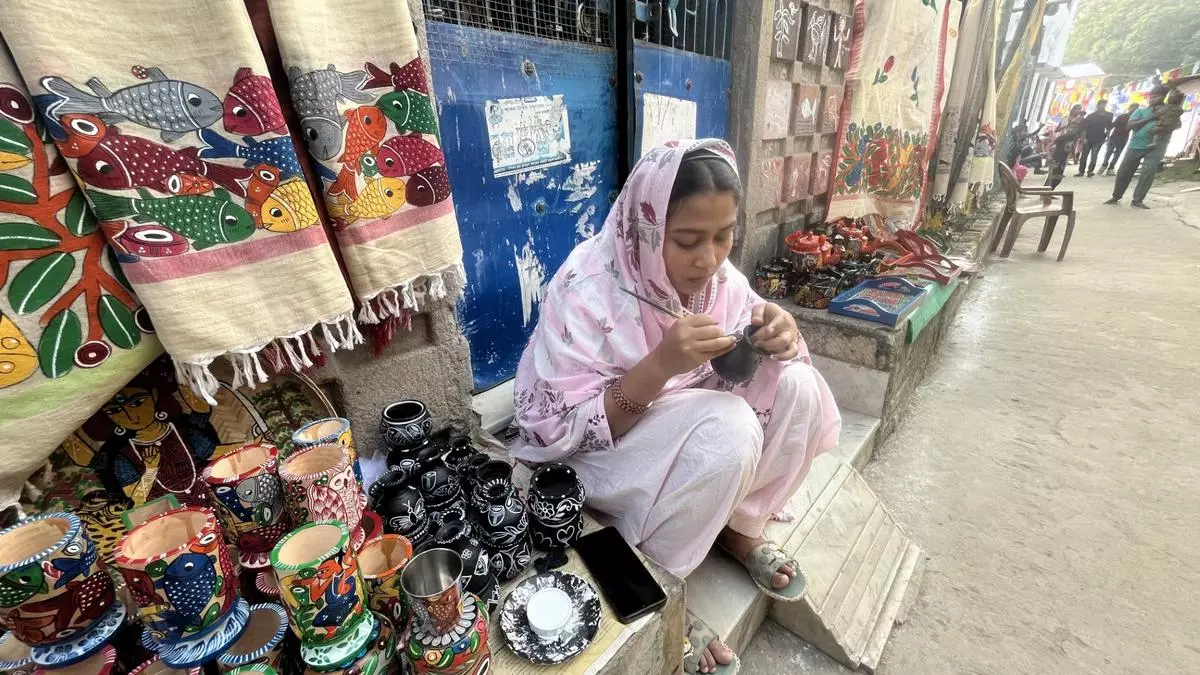
Patuas are now painting on household articles such as trays, coasters, mugs, kettles. These are popular and lucrative and help to keep the tradition alive.
| Photo Credit:
JAYANTA SHAW
Interestingly, the song-display routine has not completely disappeared. The government has found a novel way of keeping the tradition alive by using it for spreading public awareness in rural Bengal. “During COVID, we went to marketplaces at the instance of the State government and raised awareness through our songs and paintings,” said Rahim Chitrakar. The artists are often taken to schools to acquaint the students with their sociocultural past through such performances. “It has been a struggle to keep our art alive and relevant. And finally we can hope the coming generations will not have to face the kind of hardships we did as children,” said Bahar Chitrakar.
Source:https://frontline.thehindu.com/arts-and-culture/patachitra-artists-west-bengal-naya-paschim-medinipur-patuas-ancient-tradition-scroll-painting-song-dance/article69175244.ece

